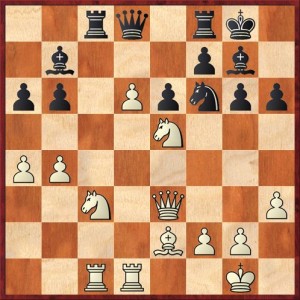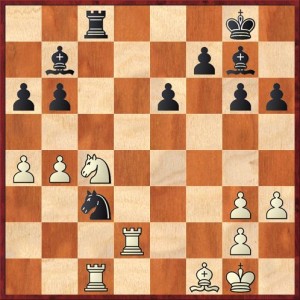After three rounds of the Bay Area International, I have one loss and two draws. The loss was against John Bryant in round 1, not too surprising as he is over 2400 FIDE. The two draws were against masters in the 2200 range, Leon Piasetski and Hayk Manvelyan. In the game against Manvelyan I definitely had some winning chances, with a pawn-up endgame, but it was one of those positions where playing to win would also give me a real chance of losing, and I finally decided not to take the risk.
The main news so far in the tournament is that the #1 seed, Shimanov, withdrew before the tournament. That’s sort of a bummer, but there are still lots of strong players here. Already in round three we had grandmasters playing against grandmasters. I think there were only five people who started 2-0, and I know that two of them drew in round three. The other games were still going. It looked as if GM Bartlomeij Macieja had Josh Friedel in trouble on board one, so Macieja may be your leader after three rounds. But of course there is still a very long way to go.
Here are a couple of highlights from rounds one and two.
FEN: 2rq1rk1/1b3pb1/pp1Ppnpp/4N3/PP6/2N1Q2P/4BPP1/2RR2K1 b – – 0 1
This was a game from round one between Tigran Ishkhanov (White) and Sam Shankland (Black). White had the upper hand for a while, but his last move, 1. Ne5?, was a serious mistake. Can you see how Shankland took advantage of it?
Here’s a little more space in case you want to think about it.
Shankland smashed the White position with 1. … Rxc3! I don’t care how many times you see them, exchange sacs on c3 never grow old! It’s quite surprising to me that Ishkhanov simply walked into this – but then, lots of things look surprising in hindsight.
I asked Sam whether he spent very long calculating this move. “No, it was mostly intuitive,” he said. However, he does out-calculate his opponent in the sequel.
2. Qxc3 …
Of course, 2. Rxc3 would give back the exchange without solving any of the problems.
2. … Nd5 3. Qg3?! …
But here, according to Sam, 3. Rxd5! had to be played.
3. … Qxd6 4. Nc4 …
I don’t think 4. f4 looks very good after 4. … g5.
4. … Qxg3 5. hg …
Sam was tempted to take on b4, but instead decides to create more weaknesses in White’s camp. It’s very instructive how he does not rush to win back his material in this position, but keeps on turning up the pressure.
5. … Nc3
If you were analyzing the position on move 1, I think that this is the point where you would stop and say that Black has more than enough compensation for the exchange.
6. Rd2? …
Losing! Sam said that 6. Re1 was forced, and then after 6. … Bd4+ 7. Kf1 (or 7. Kh2 Bf2!) 7. … Ne4! Suddenly threatens mate on g3! 8. Red1 Nxg3+ 9. Ke1 looks forced. Here Sam said he would have played 9. … Nxe2 10. Kxe3 e5, and I completely agree with him. In my opinion (and I’m not the only one), two bishops are worth about 6.5 pawns, while rook and knight are worth about 7.5. So here, where Black has two extra pawns, he is essentially a pawn up. For some reason the computer prefers 9. … e5 right away instead of 9. … Nxe2. This may be right – the knight is a great piece, so there’s no hurry to exchange it – but I think I’ll go with Sam’s intuition here instead of the computer.
In any event, Sam now finished up the game in impressive style.
6. … Rc8!
The pin on the c-file is murderous, even though technically speaking it doesn’t even exist yet.
7. Bf1 … (diagram)
FEN: 2r3k1/1b3pb1/pp2p1pp/8/PPN5/2n3PP/3R2P1/2R2BK1 b – – 0 7
Maybe Ishkhanov thought that this would save the piece. But Black keeps on piling up the threats.
7. … b5!
I would have been very, very tempted to take that a-pawn, when I think Black is much better. But Sam’s move is like an arrow heading towards its target.
8. ab ab 9. Rd7 …
If 9. Nd6 Ne2+ (I love this move—three of Black’s pieces are en prise, one of them two different ways, but he comes out ahead in all lines) White is out of luck after either 10. Bxe2 Rxc1+ or 10. Rxe2 Rxc1 11. Nxb7 Bd4+! Followed by 12. … Rxf1. How did you like the way the desperado knight deflected White’s rook away from the defense of d4?
9. … Bd5 10. Rxc3 …
White finally gives back the exchange, but it won’t save him.
10. … Bxc3 11. Nd6 Bd4+ 12. Kh2 Rc1 13. Bxb5 Bg1+
I love the way that Black’s attack keeps on going, even with only three pieces left. That’s still enough to mate.
14. Kh1 Bf2+!
Don’t even think of taking that b-pawn with 14. … Bc5+ and … 15. … Bxb4. We’re playing for mate.
15. Kh2 Rg1 White resigns.
The threat (indefensible) is … Rxg2+ followed by … Rg1+ and … Rh1 mate. Awesome! Just once I’d like my pieces to coordinate as beautifully as Sam’s did in this game.
I didn’t get to do as much spectating in round two because my game went longer. However, I did see one interesting endgame (the last game in the round to finish). Rayan Taghizadeh, a young expert, was playing Black against International Master Victor Shen. (diagram)
FEN: 7k/6p1/4P1K1/3Q4/7P/4q1P1/8/8 b – – 0 1
In this position, Rayan played the natural 1. … Qxg3+? 2. Kf7 Qf4+ 3. Ke8 Qa4+ 4. Kd8! Qxh4+ 5. e7 Qf6? (5. … Kh7 would at least make White work for the victory) 6. Kd7 Black resigns.
Now that you’ve seen how the game did end, can you tell me what Taghizadeh should have played in the initial position?
The answer is 1. … Qxe6+!! with an immediate draw. White has to play 2. Qxe6, and it’s stalemate!
Obviously both players overlooked this resource. I have a story that explains why this sort of “out-of-the-blue” move is so hard to see when you’re in the heat of battle. Last summer I watched a show on TV called “Brain Games,” in which one episode was about the way that focusing on one spot can cause you to be oblivious to things going on around you. They demonstrated this by having some spectators watch a card trick. Meanwhile, in the background, a guy walked by in a penguin costume. After the card trick was over, they asked the spectators, “Did any of you notice a penguin walking around?” None of the spectators had, and they were shocked when they saw the tape and saw this six-foot penguin walking around just a few feet away!
The moral of this story is: Don’t overlook the penguins!
1/6: Corrected a couple of typos. Thanks for pointing them out, Mike.






{ 1 comment… read it below or add one }
Great post and story. I shared this via twitter at https://twitter.com/KVChess
{ 1 trackback }